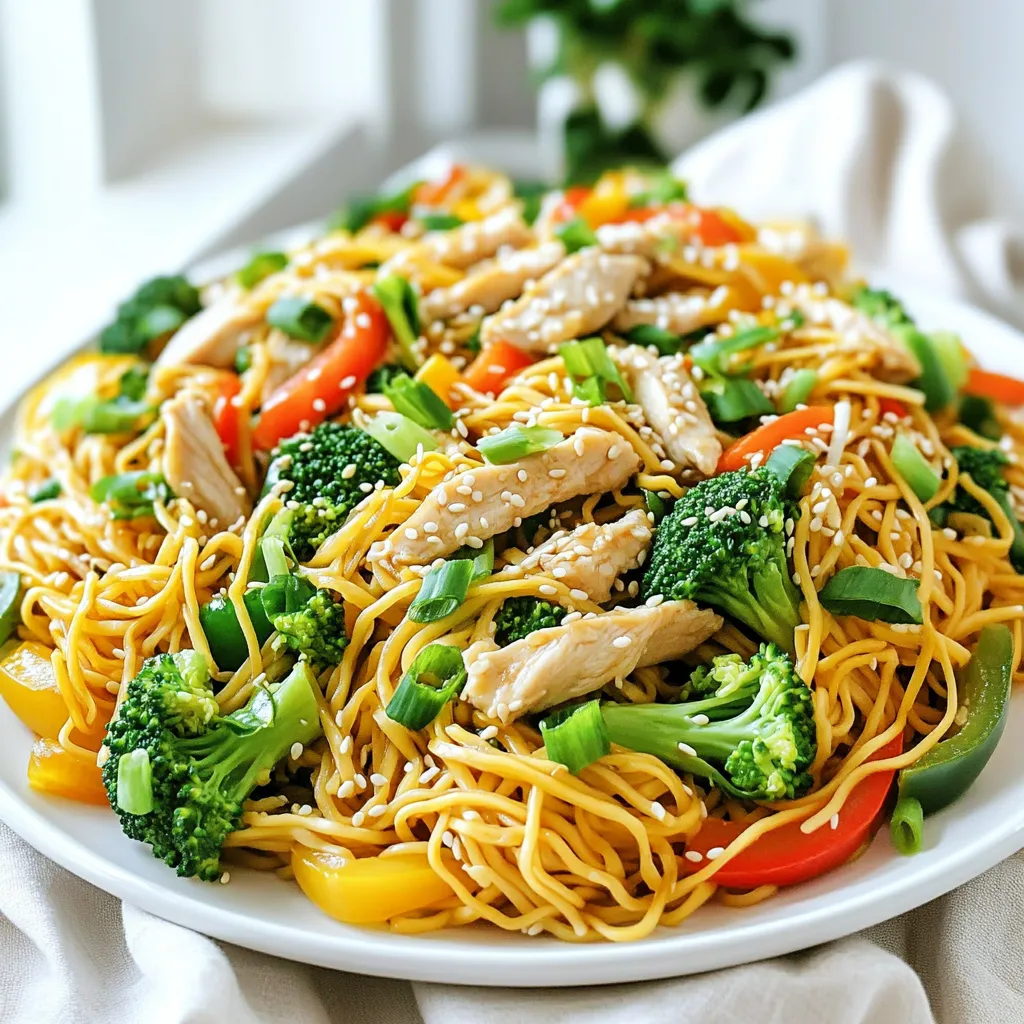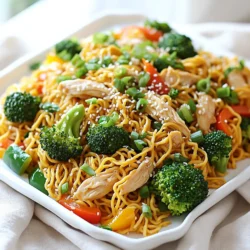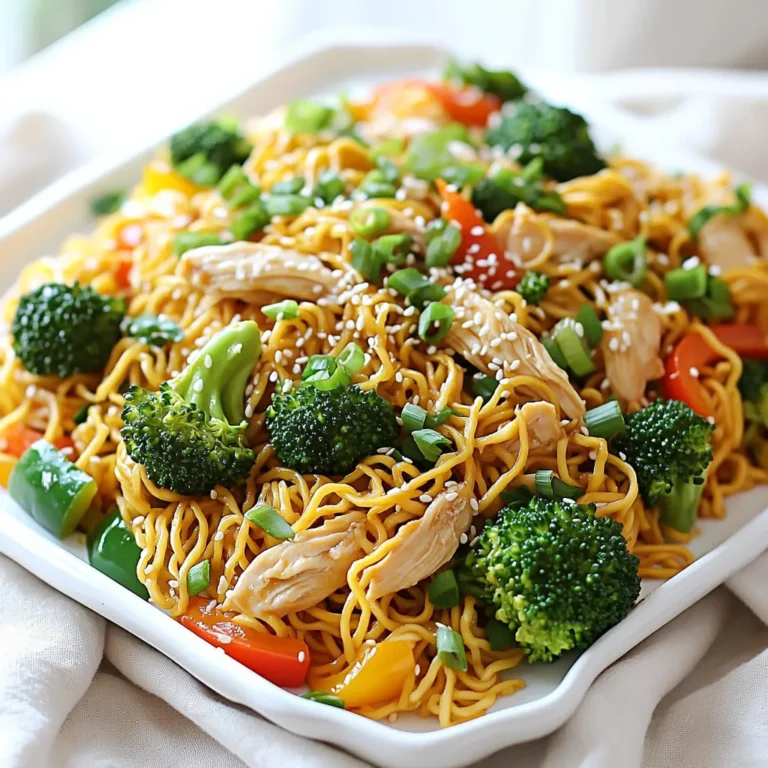Looking to whip up a meal that’s better than takeout? You’re in the right place! In “Chicken Chow Mein Better Than Takeout Delight,” I’ll guide you to create a tasty dish right in your kitchen. This chow mein recipe uses fresh ingredients, simple steps, and flavors you’ll love. Say goodbye to takeout and hello to homemade goodness that’s quick and easy. Let’s get started on this delightful culinary adventure!
Ingredients
List of Ingredients
– Chicken and Vegetable Components
– 2 boneless, skinless chicken breasts, thinly sliced
– 1 cup bean sprouts
– 1 cup broccoli florets
– 1 bell pepper, thinly sliced (any color)
– 2 green onions, chopped
– 3 cloves garlic, minced
– 1 tablespoon fresh ginger, minced
– Sauces and Seasoning
– 3 tablespoons soy sauce (low sodium)
– 1 tablespoon oyster sauce (optional)
– 1 tablespoon sesame oil
– 2 tablespoons vegetable oil (for stir frying)
– Salt and pepper to taste
– Noodle Options
– 4 cups egg noodles (or chow mein noodles)
Chicken chow mein needs fresh ingredients for the best taste. I prefer using thinly sliced chicken breasts. They cook fast and stay juicy. The veggies bring color and crunch to the dish. Bean sprouts and broccoli are my favorites. You can add any bell pepper for sweetness. Green onions add a nice bite and color.
For sauce, low-sodium soy sauce gives umami without too much salt. Oyster sauce adds depth but is optional. Sesame oil gives a warm, nutty flavor. Don’t forget salt and pepper to enhance everything.
Noodles are the star. I use egg noodles, but chow mein noodles work too. They soak up flavors well. When you gather all these ingredients, you create a colorful, tasty meal that is better than takeout!
This dish is quick, tasty, and satisfying. It’s easy to make at home and very customizable.
Step-by-Step Instructions
Preparation Steps
– Cooking the Noodles
First, cook the egg noodles. Boil water in a big pot. Add the noodles and cook as directed on the package. Once they are soft, drain the noodles. Set them aside for later.
– Sautéing the Aromatics
In a large skillet or wok, heat two tablespoons of vegetable oil over medium-high heat. Add three cloves of minced garlic and one tablespoon of minced ginger. Stir for about 30 seconds until they smell good.
– Stir-Frying the Chicken
Next, add the two thinly sliced chicken breasts to the pan. Sprinkle salt and pepper over the chicken. Cook for 5 to 7 minutes, stirring often, until the chicken is no longer pink.
Cooking the Vegetables
– Adding the Bell Pepper and Broccoli
Now it’s time for the veggies! Add one sliced bell pepper and one cup of broccoli florets. Stir-fry them with the chicken for about 3 to 4 minutes. The veggies should be bright and crisp.
– Incorporating the Bean Sprouts
Toss in one cup of bean sprouts. Keep stirring for another minute. This adds a nice crunch to your dish.
Finalizing the Dish
– Combining Noodles with Chicken and Vegetables
Add the cooked noodles to the skillet. Pour in three tablespoons of low-sodium soy sauce, one tablespoon of oyster sauce if you want, and one tablespoon of sesame oil. Toss everything together well.
– Adjusting the Seasoning
Stir in two chopped green onions. Cook for one more minute. Taste your chow mein and add more salt or pepper if needed.
Enjoy your Chicken Chow Mein that’s better than takeout!
Tips & Tricks
Tips for Perfect Chicken Chow Mein
– Selecting the Right Noodles: Use egg noodles or chow mein noodles. Egg noodles are softer and soak up sauce well. Chow mein noodles are firmer and give you a nice bite. Choose what you like best. Cook them according to the package. Drain and set aside.
– Techniques for Stir-Frying: Heat your skillet or wok before adding oil. This keeps the chicken from sticking. Use high heat and a quick motion to stir. This method keeps the chicken juicy and the veggies crisp. Don’t overcrowd the pan; cook in batches if needed.
Enhancing Flavor
– Using Fresh Ingredients: Fresh chicken, crisp veggies, and herbs make a big difference. They add bright flavors that dried or old ingredients can’t match. Use fresh garlic and ginger for a punch. Fresh green onions give a nice crunch and color.
– Optional Ingredients for Added Flavor: Consider adding oyster sauce for a deeper taste. It brings richness to the dish. You can also toss in sesame seeds for a nutty finish. Lime wedges on the side add a fresh zing. Mix and match to find your favorite flavor combinations.

Variations
Alternative Proteins
You can switch up the protein in your chow mein. Shrimp adds a nice twist. It cooks fast and gets a sweet flavor. Just sauté it like chicken. Tofu is a great choice too. It soaks up the sauce well. Use firm tofu and press it before cooking. Cut it into cubes for perfect bites.
If you want a vegetarian chow mein, just skip the meat. Load it up with veggies. Try mushrooms for a meaty texture. Add chickpeas for protein. You can mix in your favorite greens like spinach or kale. This way, you stay healthy and enjoy the meal.
Vegetable Substitutes
Don’t be afraid to get creative with veggies! You can use seasonal options to keep it fresh. In summer, use zucchini and snap peas. They add crunch and flavor. In winter, consider using carrots and cabbage. They bring sweetness and a nice bite.
For extra nutrients, think about adding more greens. Kale, bok choy, or even spinach work great. You can also toss in bell peppers of different colors for a vibrant look. Adding nuts like cashews or peanuts gives a crunchy texture. This makes your chow mein not just tasty but also exciting!
Storage Info
How to Store Leftovers
To keep your Chicken Chow Mein fresh, choose the right containers. I recommend using airtight glass containers. They keep your meal safe and tasty. You can also use plastic containers, but make sure they seal well. This helps avoid spills in your fridge.
For freezing, use freezer-safe bags or containers. Remove as much air as possible before sealing. This prevents freezer burn. Label your bags with the date. This helps track how long your chow mein has been in the freezer.
Reheating Methods
When it’s time to eat, you have two great options: stovetop or microwave. The stovetop is my favorite. It warms the chow mein evenly and keeps it tasty. Just add a bit of water or oil in the pan. Heat over medium until hot.
If you’re in a hurry, the microwave works too. Place your chow mein in a microwave-safe bowl. Cover it with a damp paper towel to keep moisture in. Heat it in short bursts, stirring in between. This keeps the flavor and texture nice.
FAQs
Common Questions About Chicken Chow Mein
Can I use instant noodles?
Yes, you can use instant noodles. They cook fast and are easy to find. Just follow the package instructions. Rinse them with cold water to stop the cooking. This keeps them from getting mushy. Add them to your stir-fry last. This way, they stay firm and tasty.
How do I make it gluten-free?
To make Chicken Chow Mein gluten-free, choose rice noodles or gluten-free noodles. For sauces, use gluten-free soy sauce. Always check labels to avoid hidden gluten. This ensures a safe meal for those with gluten sensitivities.
Tips for Serving
What to serve with Chicken Chow Mein?
Pair Chicken Chow Mein with a light soup or spring rolls. A fresh salad adds crunch and balance. Choose something with bright flavors. Lime wedges on the side give a nice kick too.
How to achieve restaurant-quality presentation?
For a stunning look, use a large white plate. Arrange the chow mein in the center. Add a sprinkle of sesame seeds and chopped green onions on top. A small dish of lime wedges completes the plate. This adds color and makes it pop!
In this article, we explored how to make Chicken Chow Mein, from gathering ingredients to storage tips. You learned about the right noodles, perfect cooking methods, and flavorful variations. Don’t hesitate to experiment with proteins and vegetables. This dish is flexible and tasty. With these instructions, you can create a wonderful meal at home. Enjoy showcasing your cooking skills and sharing this delightful dish with others!



